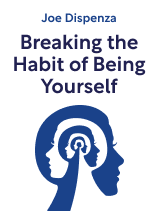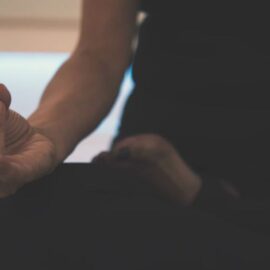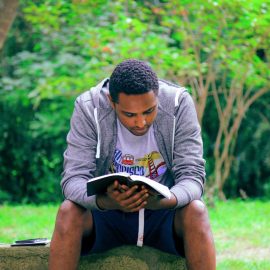

This article is an excerpt from the Shortform book guide to "Breaking the Habit of Being Yourself" by Joe Dispenza. Shortform has the world's best summaries and analyses of books you should be reading.
Like this article? Sign up for a free trial here.
Can you change your past? How can you utilize the principle of quantum entanglement to influence your past and your future?
According to Joe Dispenza, the past, present, and future are all connected by the principle of quantum entanglement. When two particles become entangled, whatever is done to one particle is done to the other, no matter how far apart they are in space. It’s the same with the present and the past.
Here’s how you can change your past and future by changing your present using quantum entanglement.
Quantum Entanglement
According to Dispenza, changing your past is a matter of quantum physics. Quantum physics is the study of physical properties of matter at the quantum—or atomic and subatomic—level. The principles of quantum entanglement demonstrate that everything is connected. All matter is made up of atoms, which are made up of subatomic particles like nuclei and electrons. When two particles become entangled, whatever is done to one particle is done to the other no matter how far apart they are in space.
(Shortform note: Quantum entanglement can only occur between a pair of particles that interact with each other physically. Scientists can create entangled particle pairs, or they can occur randomly, but Dispenza doesn’t make clear how this principle extends beyond the quantum level to connect everything in existence.)
Dispenza suggests that the same entanglement principles apply to time, and that doing something in the present can change your past. He describes a study in which participants were instructed to pray for a group of patients who were suffering from sepsis, alongside a control group of sepsis patients who were not prayed for. The study saw greater improvements in the outcomes for the prayed-for group, but the twist is that the patients in the study weren’t currently being treated for sepsis but instead had been treated four to ten years prior. Dispenza presents this as proof that the way we think and behave in the present can literally change our past.
(Shortform note: The study cited by Dispenza was one of the British Medical Journal’s yearly spoof articles. The information in the article was not false, but it was presented as evidence of a deliberately absurd and satirical conclusion. Dispenza is not the only one to have cited this article as genuine evidence of the effects of prayer. This is because these spoof articles are archived in online databases the same way serious articles are, with no obvious indication that they are satirical. However, that doesn’t mean there’s no basis for Dispenza’s claims: A theory called retrocausality does suggest that measuring a particle in the present could influence it in the past, but the idea is generally regarded with skepticism in the scientific community.)
So the actions you take now determine your past and future, but you must choose what past and future you want for yourself. An electron orbiting in an electron cloud represents an infinite number of possible locations and, until observed, exists only as potential. Since all physical matter is made up of these subatomic particles that make up atoms, Dispenza says all of our reality is made up of potential—of past, present, and future realities that simultaneously exist and don’t exist. It is up to us to observe and select that potential option to achieve an experience.
| Quantum Superposition and the Idea of Infinite Potential Realities The concept of the co-existence of multiple potential realities in quantum physics is called superposition. However, the idea that it can be applied to objects of a larger scale than the quantum level or to our daily lives is not supported by the scientific community, as was illustrated by the famous thought experiment by Erwin Schrödinger. The experiment involved placing a cat in a box with a radioactive substance that, as it began to decay, would cause a poison to be released into the box. If the idea of quantum superposition were applied to the box, the principle would hold that the cat is simultaneously alive and dead until someone opens the box and checks the cat’s status. The idea that a cat could be both alive and dead at the same time was meant to point out the absurdity of trying to apply the principle of quantum superposition to non-quantum reality. |
Though you can choose an experience you want you can’t control how that experience comes to be. According to Dispenza, you manifest the “what” and let quantum mechanics take care of the “how.” If your goal is to be happily married with a career you love, you can focus your intention on achieving those things, but how you achieve them will be up to the universe. Stay focused on that goal and don’t get bogged down in the details of how it will happen. If you align your thoughts, feelings, and habits to manifest what you want, it will come to you like magic, usually in a way you could have never seen coming.
(Shortform note: In You Are a Badass, Jen Sincero also suggests that you need to focus on what you want to achieve and leave the “how” up to the universe. She adds that you should make physical representations of your intentions like a vision board and surround yourself with others who will support you in your pursuit of change and growth.)

———End of Preview———
Like what you just read? Read the rest of the world's best book summary and analysis of Joe Dispenza's "Breaking the Habit of Being Yourself" at Shortform.
Here's what you'll find in our full Breaking the Habit of Being Yourself summary:
- How your habits are keeping you from growing
- How to unlearn your harmful habits to create a new you
- A four-step meditative practice to help you learn new habits






